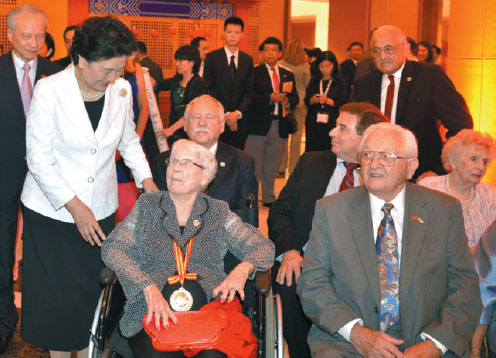
Vice-Premier Liu Yandongmeets Flying Tigers pilots and their families inWashington on Thursday. (Wang Lei/Xinhua)
Vice-premier among the many who connect with the U.S. pilots who helped China's wartime resistance.
Fighter planes roared above Yangtang village, weaving and diving in a deadly dance, filling the evening sky with the staccato cough of machine-gun fire.
It was 1944, and the air force of the Imperial Japanese Army all but ruled the skies over battle-scarred China.
Long Fenggao was 9 years old the day warplanes clashed over his village, near Guilin in the Guangxi Zhuang autonomous region. He had already lost his mother to a Japanese germ bomb four years earlier, and he would soon be orphaned when another raid would kill his father.
But on that day, his salvation came in the form of a squadron of outgunned Curtiss P-40 Warhawks, their noses painted to resemble gaping shark jaws.
They were the only thing standing between the Japanese and total aerial supremacy over China, a ragtag group of pilots called the American Volunteer Group when they entered the war in 1941. Their friends and enemies knew them by their nickname, the Flying Tigers.
As they took on the Japanese war machine in the skies of Yangtang, Long suddenly saw a sliver of hope. Hours later, when villagers found an injured U.S. pilot in a rice field, he would repay that hope in spades.
This year, as the United States commemorates the 70th anniversary of the end of World War II, China is preparing to mark the conclusion of the War of Resistance against Japanese Aggression (1937-45).
A bloody chapter in the global conflict, Western and Chinese historians have only recently begun to shine a light on how China's resistance against Imperial Japan played a crucial role in the greater Allied victory, and how support from the U.S. - including vital supplies flown in over the Himalayas by the brave American "hump" pilots - enabled China to stay in the fight.
Many of China's stories of camaraderie and shared sacrifice with the U.S. have long been overlooked. Seven decades on, however, there are those who still remember.
For Chinese Vice-Premier Liu Yandong, who is in Washington for the seventh U.S.-China Strategic and Economic Dialogue, her connection to the U.S.-China wartime collaboration is deeply personal. During a diplomatic exchange in 2011, she presented Hillary Clinton, then the U.S. secretary of state, with a photograph of her father, Liu Ruilong, with a Flying Tiger pilot that he helped save.
As a young man fighting against the Japanese, Liu's father joined in a mission to rescue five U.S. flyboys after their plane was shot down. Several soldiers died in the operation. "I still keep an old photo telling the story of my father, an anti-Japanese military leader, risking his life to rescue American pilots and sacrificing three of his own soldiers," Liu was quoted as saying.
Clinton, now a presidential hopeful, reportedly said she would hang the picture on the wall of her office as a reminder of the historical ties that bind the U.S. and China.
Those ties began in earnest in early 1941, when retired U.S. army air corps officer Claire Lee Chennault brought 100 outdated Warhawks to China, along with 99 U.S. pilots and ground crew who had all resigned commissions in the U.S. military to join the fight.
Technically a mercenary outfit, but widely believed to be unofficially sanctioned by the U.S. government before war was declared on Japan in December 1941, in the early days the American Volunteer Group presented China's only real air resistance to the Imperial Japan Army.
















































